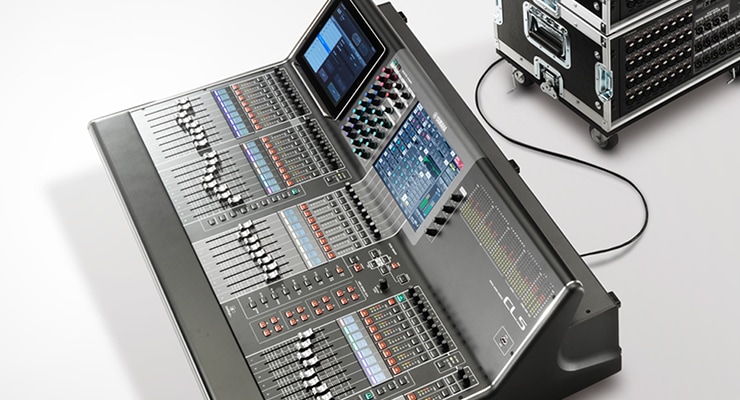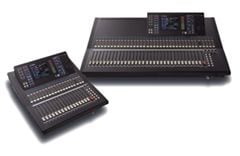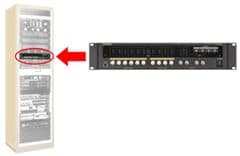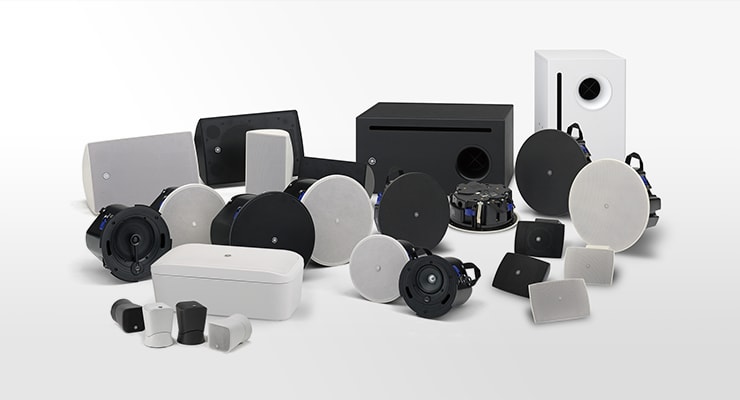Better Sound for Commercial Installations
Part 3: Mixers and Processors

02. Console and Rack Mount Mixers
Both digital and analog mixers are available in console configurations that are normally used on table top or stand, and rack-mount configurations with vertical control panels designed for installation in standard equipment racks. The choice will depend on the application, the type of operability required, and the space available.
Console Types for Detailed Hands-on Control

The control panels on console type mixers offer plenty of space for a large number of controls, including linear faders for precision level control as well as easy visual confirmation of relative levels. This configuration is preferred for applications that require complex input and output connections as well as real-time control of levels and other sound parameters. Depending on the type of console and number of inputs and outputs used, an experienced operator may be necessary. For these reasons console type mixers are most commonly used by professionals at live events, while rack-mount type consoles, described next, are most commonly chosen for commercial installations.
(Figure: Console type mixers have spacious panels that provide good visibility and facilitate detailed adjustment. (Photo: Yamaha LS9 series mixers).)
Rack Mount Types for Compact Installations

Rack-mount mixers suitable for compact system designs are commonly chosen for installations where frequent level or tonal adjustments are not required. Some mixers in this category are designed with a minimum of panel controls, making them ideal for permanent installations.
The Yamaha IMX644 rack-mount digital mixer, for example, only has level controls knobs and memory selector buttons on its panel. Just by looking at the panel you might assume that this mixer has a very limited set of features, but in reality it includes automated feedback suppression, a "priority ducker" function that automatically lowers the background music level when an announcement is being made, and a variety of other features that are useful in commercial installations (see the"Automated Mix Functions" section for more details). Automating complex tasks like feedback control and some level control operations minimizes the need for staff to make manual adjustments.
These types of functions need to be properly set up to match the needs of the facility during initial installation, but that procedure is easily accomplished via the comprehensive, intuitive interface provided by the IMX644 Manager application running on a computer connected to the mixer via a USB cable. Once the parameters that determine the system's basic sound and operation have been set up via the IMX644 Manager, day-to-day level control and memory selection can be easily accomplished from the front panel.
(Figure: A compact rack-mount mixer designed for installation use. (Photo: Yamaha IMX644))
Other Devices Can Be Rack Mounted Too

Processors, power amplifiers, and even input devices such as CD players are also available in rack-mount configurations, so core components including the mixer can be conveniently installed in one or more standard equipment racks for a compact, orderly system. Rack mounting also makes it easy to keep cables short, and minimizes the possibility of cable damage or accidental disconnection.
Standard racks for audio equipment, sometimes referred to as "19-inch racks," conform to EIA (Electronic Industries Alliance) specifications. You'll sometimes see terms like "1U" or "2U" in the specifications for rack-mountable equipment. The "U" is an EIA standard unit that refers to the amount of vertical rack space the device will occupy, and therefore height of the device. A 1U rack space is 44.45 millimeters (1.75 inches) high.
(Figure: Using rack-mount processors, power amplifiers, CD players, and other devices makes it possible to create compact, orderly systems.
(Photo: Yamaha CD-S300RK rack-mountable CD player))
Up to this point we have focused on the sound system devices used for mixing, amplification, and output. In the next section we'll examine processing, or the application of effects that can be used to modify the sound in a variety of ways.
Contents
The sound systems that broadcast the information you're hearing have been carefully designed and installed to suit the needs of each individual facility.
This series offers information aimed at achieving the best possible sound in commercial installations, from the basics to equipment selection and day-to-day operation.








